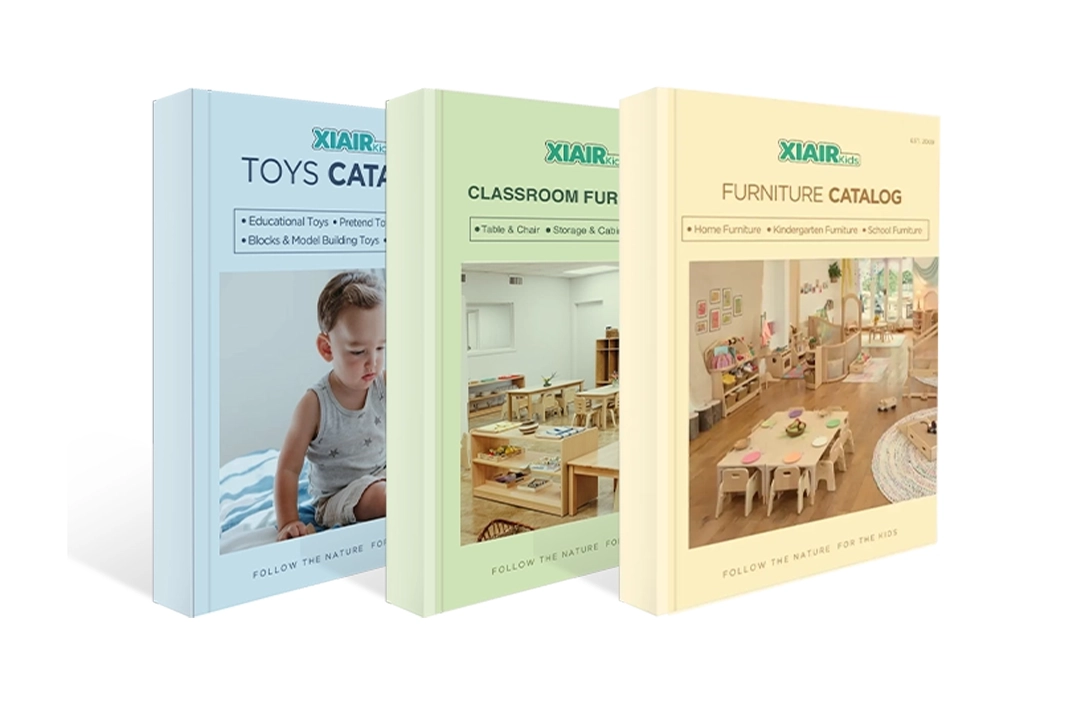In early childhood education, Circle Time is an essential activity where young learners gather to interact, learn, and develop social skills. However, many educators face the challenge of keeping Circle Time engaging. Children can quickly lose interest without fresh ideas, making maintaining their attention and fostering meaningful participation difficult. Do you find it challenging to find educational and fun circle time activities?
To address this challenge, we’ve put together 40 innovative circle time activities that will help keep your daycare classroom dynamic and your students engaged. These activities are designed to capture children’s attention and encourage creativity, collaboration, and social skills—all in a fun and educational setting.
In the following sections, you’ll discover various circle time activities that will breathe new life into your teaching practice and provide your students with an enriching learning experience they’ll look forward to daily.
What Is Circle Time for Preschoolers?
Circle time is a structured period during the school day when preschoolers gather together in a circle to participate in group activities. It is a key component of early childhood education as it promotes socialization, communication, and cognitive skills. During circle time, children engage in activities encouraging learning, such as singing songs, reading stories, discussing the day’s schedule, or practicing new concepts like colors, shapes, and numbers.
Circle time is typically led by a teacher or educator who guides the group through educational and fun activities. It’s a chance for young children to interact with their peers, learn to listen and take turns, and develop a sense of routine and structure. Children learn new information in well-planned circle time activities and practice important social and emotional skills such as cooperation, empathy, and self-regulation.
Circle time activities can vary greatly depending on the school’s educational philosophy or the children’s needs. For example, circle time might focus more on self-directed learning and discovery in a Sala de aula Montessori. In contrast, a Reggio Emilia-inspired classroom could be centered around exploration through art, music, or nature. However, regardless of the approach, circle time remains a central and valuable part of the preschool day.
In essence, circle time for preschoolers is not just about sitting in a circle—it’s about creating a dynamic, interactive space where children can grow intellectually, socially, and emotionally.
40 Circle Time Activities for Preschoolers
To make circle time activities effective and enjoyable, it’s essential to incorporate a variety of activities that not only capture children’s attention but support their development across various domains. This section has compiled 40 fun and educational circle time activities designed to engage preschoolers, promote cooperative play, and reinforce key skills. Here are preschool circle time ideas:
1. Singing Songs with Actions
How it Works: During circle time, the teacher leads the children in singing simple, interactive songs like “Head, Shoulders, Knees, and Toes” or “If You’re Happy and You Know It,” incorporating hand movements or body actions to accompany the lyrics.
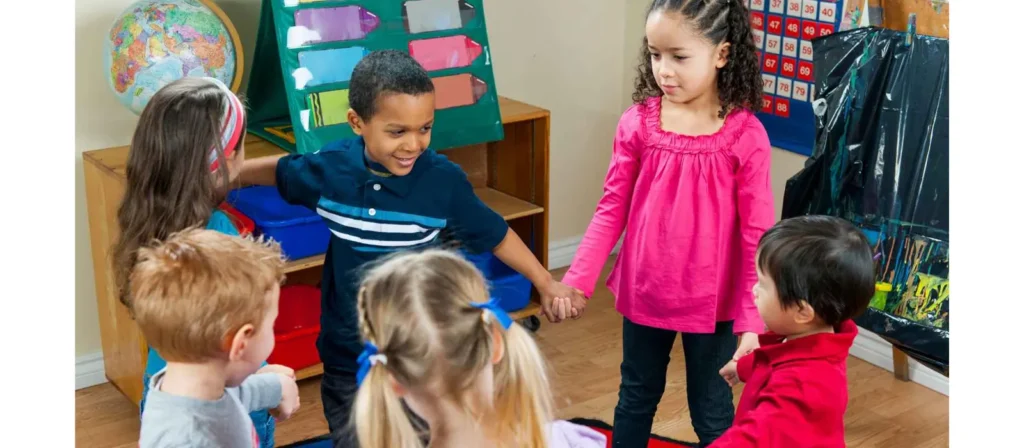
Benefícios: This activity promotes physical coordination, helps develop fine and gross motor skills, and encourages children to follow instructions. It also fosters language development as they learn new vocabulary through song.
2. Storytelling with Props
How it Works: The teacher reads a story and uses props, such as puppets, toy animals, or objects, to make the tale come to life. Children are encouraged to interact with the props while listening to the story.
Benefícios: This activity enhances listening skills, sparks imagination, and helps children understand narrative structure. It also encourages language development and builds vocabulary by introducing children to new words in context.
3. Pass the Beanbag
How it Works: Children sit in a circle while passing a beanbag to the music. When the music stops, the child holding the beanbag shares something about themselves or answers a question from the teacher.
Benefícios: This activity teaches children about taking turns, improves listening skills, and promotes social interaction. It also encourages speaking in front of a group, which boosts confidence and self-expression.
4. I Spy with My Eye
How it Works: The teacher starts by saying, “I spy with my eye something that is [color/shape],” the children take turns guessing what object the teacher is referring to in the room or during an outdoor activity.
Benefícios: This game helps improve observational skills, supports color and shape recognition, and encourages cognitive development. It also fosters attention to detail and sharpens listening and speaking skills.
5. Animal Movements
How it Works: The teacher calls out different animals, and children act out how they move—like hopping like a frog or slithering like a snake—while making the associated animal sound.
Benefícios: This activity promotes gross motor development, balance, and coordination. It also encourages imagination and helps children associate animals with their characteristics while engaging in fun physical activity.
6. Feelings Flashcards
How it Works: The teacher shows flashcards with pictures of emotions (happy, sad, angry, etc.) and asks the children to mimic the expressions on the cards. Then, the children take turns talking about times they felt that way.
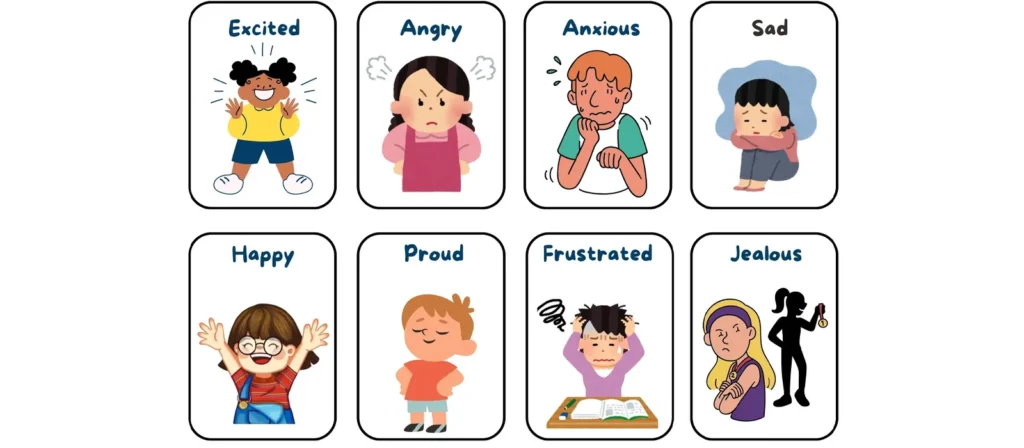
Benefícios: This activity fosters emotional intelligence by helping children recognize and name their emotions. It encourages self-awareness and empathy and improves social interactions among peers.
7. Color Sorting Game
How it Works: Children are given a set of colorful objects (such as buttons or blocks) and are asked to sort them by color. The teacher may guide them in counting how many items are in each group.
Benefícios: This activity enhances color recognition, hand-eye coordination, and sorting skills. It also supports basic math concepts such as counting and grouping, helping children develop early numeracy skills.
8. Shadow Play
How it Works: The teacher uses a flashlight or lamp to create shadows on a wall and asks the children to guess what objects create them. The children can also try to create shadows by positioning their hands or objects.
Benefícios: This activity sparks curiosity about light and shadow, promoting critical thinking and problem-solving. It also helps with hand-eye coordination and introduces basic science concepts in an interactive and fun way.
9. Simon Says
How it Works: The teacher gives commands starting with “Simon says,” such as “Simon says touch your toes,” and children must follow only when “Simon says.” If the teacher gives a command without saying, “Simon says,” children should not follow it.
Benefícios: This game improves listening skills, impulse control, and attention span. It also teaches children about following directions and helps them develop physical coordination and self-regulation in a playful setting.
10. Freeze Dance
How it Works: Children dance freely to music; when it stops, they must freeze until it starts again. The teacher can call out different poses or actions to make it fun.
Benefícios: Freeze Dance helps develop gross motor skills, balance, and coordination. It also teaches children self-control and listening skills, as they need to freeze at the right moment.
11. Weather Watchers
How it Works: The teacher discusses the current weather with the children daily. The children are asked to describe the weather (sunny, rainy, windy, etc.) and dress a weather puppet accordingly.
Benefícios: This activity supports cognitive development by teaching children about weather patterns and seasons. It also encourages vocabulary expansion and observation skills.
12. Musical Chairs
How it Works: In this game, children walk around a circle of chairs while music plays. When the music stops, they must find a chair to sit in. One chair is removed after each round.
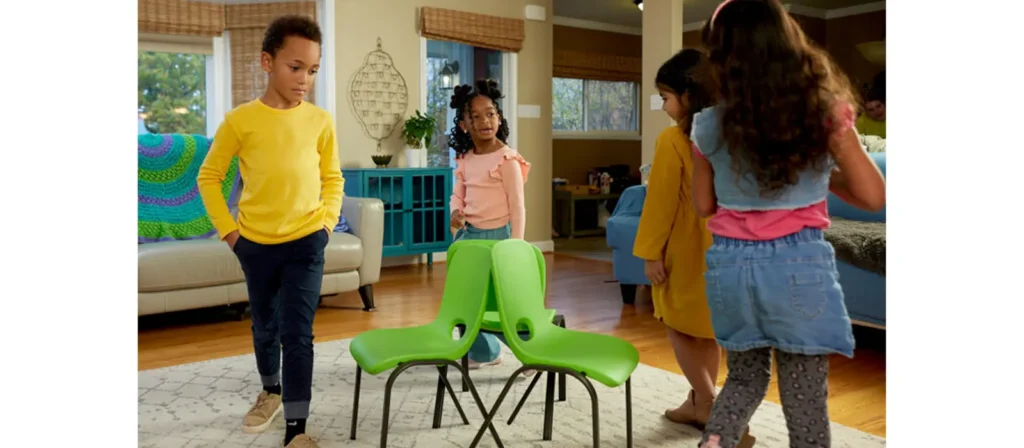
Benefícios: Musical Chairs promote listening skills, quick thinking, and physical activity. They also help children develop spatial awareness and learn how to deal with winning and losing in a group setting.
13. Name That Sound
How it Works: The teacher plays different sounds (animal noises, instruments, nature sounds, etc.), and the children guess the sound. The children can also take turns creating sounds for the group to guess.
Benefícios: This activity enhances auditory discrimination, listening skills, and memory. It also encourages vocabulary development and stimulates children’s ability to identify and associate sounds with objects or animals.
14. Magic Box
How it Works: The teacher introduces a mystery box filled with various objects. Children take turns pulling an item out of the box without looking and describing it to the group, guessing what it might be.
Benefícios: This game boosts creativity and language skills as children learn to describe objects and express their ideas. It also helps with cognitive development by encouraging curiosity and critical thinking.
15. Guess the Animal
How it Works: The teacher gives clues about an animal (e.g., “I have a long neck, and I eat leaves”) while the children guess which animal it is. Children can also take turns providing clues for others to guess.
Benefícios: This activity improves cognitive skills, such as memory and logical thinking, while enhancing vocabulary and animal recognition. It encourages children to think critically and share their knowledge.
16. Follow the Leader
How it Works: The teacher acts as the leader, performing simple actions (e.g., clapping hands, stomping feet) for the children to follow. Children can take turns being the leader and guiding the group.

Benefícios: Following the Leader promotes physical activity, coordination, and listening skills. It also encourages leadership and social interaction as children learn to follow instructions and take turns.
17. Story Dice
How it Works: The teacher uses a set of dice with pictures (e.g., animals, objects, actions) on each side. Children take turns rolling the dice and then creating a short story based on the pictures that appear.
Benefícios: This activity fosters creativity, language development, and storytelling skills. It also helps with memory and encourages children to think imaginatively as they construct their stories.
18. What’s Missing?
How it Works: The teacher places objects in the circle’s center and then asks the children to look carefully. After a few seconds, the teacher removes one item, and the children must guess which one is missing.
Benefícios: This activity enhances memory, concentration, and attention to detail. It also helps with cognitive skills like object recognition and boosts problem-solving abilities as children determine what’s missing.
19. Shape and Color Hunt
How it Works: The teacher calls out a color or shape, and the children search the preschool classroom for objects that match that description. After finding an item, they return to the circle and share what they found.
Benefícios: This activity helps shape and color recognition, observational skills, and vocabulary development. It encourages children to explore their environment and makes learning fun and interactive.
20. Pairs Matching Game
How it Works: The teacher creates pairs of cards with matching pictures (e.g., a pair of animals, shapes, or numbers) and spreads them out face down. Children take turns flipping over two cards simultaneously, trying to match them.
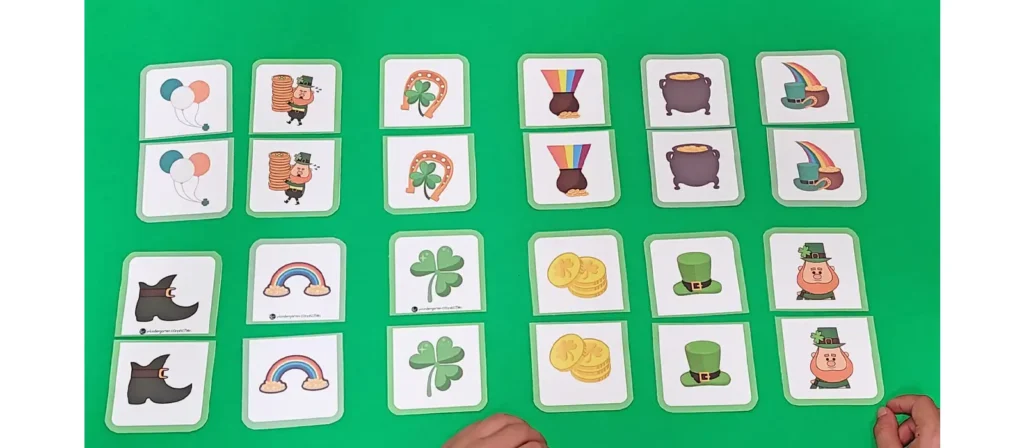
Benefícios: This activity promotes memory, concentration, and cognitive development. It also helps recognition of shape, color, or number and encourages turn-taking and patience.
21. All About Me Chart
How it Works: Each child shares a personal fact about themselves, like their favorite food, color, or hobby. The teacher writes these down on a chart, and each child takes turns reading their fact aloud to the group.
Benefícios: This activity promotes self-expression and builds confidence. It also encourages listening and speaking skills while helping children learn more about themselves and each other.
22. Balloon Toss
How it Works: The teacher tosses a balloon at the children sitting in a circle. The children must work together to keep the balloon from touching the ground, using only their hands to hit it back into the air.
Benefícios: This activity promotes teamwork, coordination, and gross motor skills. It also encourages collaboration, as children must communicate and work together to keep the balloon in the air.
23. Shadow Puppet Theater
How it Works: The teacher creates shadow puppets on the wall using a light source and simple puppets. Children can watch the shadows and try to create their own, telling a story using the shadows.
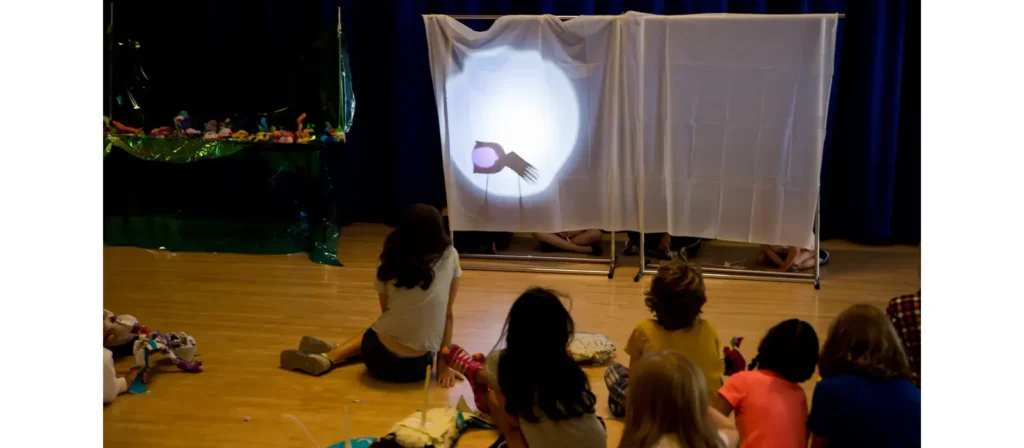
Benefícios: Shadow puppets promote creativity and storytelling skills. They also enhance understanding of light and shadows, helping children grasp basic science concepts.
24. Puddle Jumping
How it Works: The teacher creates “puddles” on the floor using soft mats or paper, and the children jump from puddle to puddle without stepping on the floor. This can be done in different patterns or with timed challenges.
Benefícios: Puddle Jumping helps with gross motor skills, balance, and coordination. It also encourages physical activity and teaches children to follow instructions and work within rules.
25. Letter Sound Hunt
How it Works: The teacher asks the children to find objects that start with a particular letter sound in the room. For example, if the teacher says “B,” children might find a ball, book, or block.
Benefícios: This activity strengthens phonemic awareness and letter recognition. It also helps children connect sounds with letters, supporting early literacy skills.
26. Telling Time with a Clock
How it Works: Using a toy clock, the teacher demonstrates how to read the time and asks the children to mimic setting it to certain hours (e.g., “Set the clock to 3:00”).

Benefícios: This activity introduces children to basic concepts of time and helps develop early math skills. It promotes problem-solving and understanding of numbers and their real-world applications.
27. Sensory Bottle Exploration
How it Works: The teacher provides sensory bottles filled with various items, such as glitter, beads, or colored water. Children shake the bottles, observe the movement inside, and discuss what they see and feel.
Benefícios: Sensory bottles support sensory exploration and concentration. They also promote vocabulary development as children describe their observations and discuss the bottle’s contents.
28. Clapping Patterns
How it Works: Create a simple clapping rhythm and ask the children to repeat it after you. Gradually increase the complexity by adding more claps or varying the rhythm. You can also encourage children to create their patterns for others to follow.

Benefícios: This activity helps develop auditory discrimination, rhythm, and memory. It also improves fine motor coordination and attention span as children focus on replicating the patterns.
29. Roll the Ball Name Game
How it Works: Children sit in a circle. One child rolls a softball to another and says the recipient’s name aloud. The game continues until everyone has had a turn.
Benefícios: This activity helps with name recognition, builds classroom community, and supports social-emotional development through peer interaction.
30. Alphabet Pass
How it Works: The teacher says a letter of the alphabet and passes the card to the left. The next child must say a word that starts with that letter before passing it on.
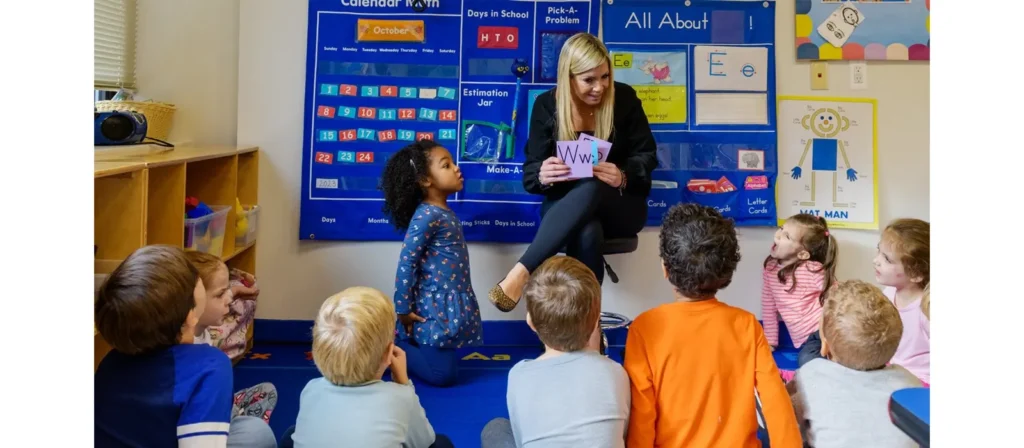
Benefícios: This game supports early literacy, vocabulary development, and phonemic awareness, all while reinforcing turn-taking.
31. Memory Circle
How it Works: The first child says a word (e.g., “apple”), the next repeats it, and adds a new word (e.g., “apple, ball”), continuing around the circle to build a chain. The game continues until a child forgets the sequence or can’t recall the correct order.
Benefícios: Improves memory, sequence processing, and vocabulary recall. Also teaches patience and active listening.
32. Guess the Leader
How it Works: One child leaves the room, and the remaining children choose a “leader.” The leader performs subtle actions (like tapping their foot, clapping their hands, or making a face). The returning child must observe and guess who the leader is based on their actions.
Benefícios: This game enhances observation, focus, and critical thinking skills. It promotes engagement with the group and encourages social interaction.
33. Silly Story Circle
How it Works: The teacher starts a story by saying a sentence (e.g., “Once upon a time, there was a purple elephant…”). The next child adds to the story, and each child in the circle takes turns adding one sentence at a time, creating a silly and unique group story.
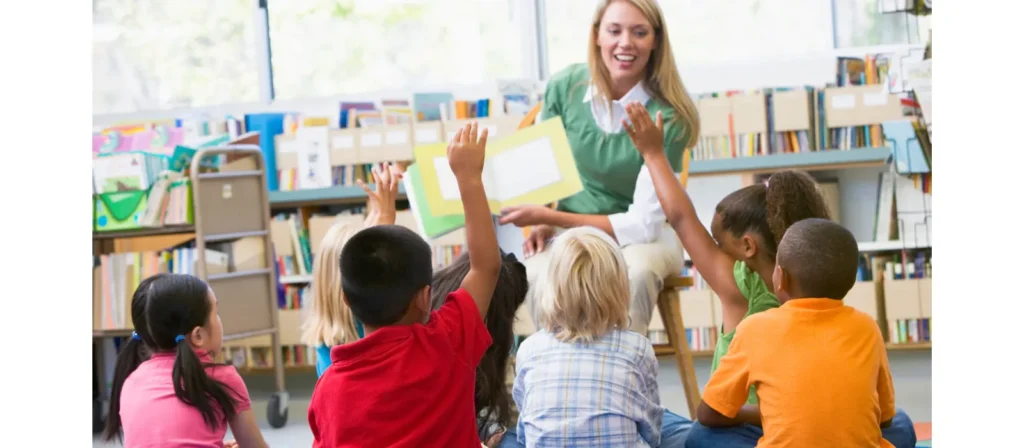
Benefícios: This activity fosters creativity, language development, and collaboration. It enhances listening skills and narrative development as children create a fun, collective story.
34. Shape Sorting with Music
How it Works: The teacher plays music while children walk or dance around the room. When the music stops, children must quickly find a shape on the floor or a shape card that matches a shape the teacher calls out.
Benefícios: This activity reinforces shape recognition, listening skills, and movement. It also helps children practice following directions and enhances their ability to focus and respond quickly to cues.
35. Animal Matching Game
How it Works: The teacher shows pictures of animals and their habitats or sounds, and children are asked to match the animal with the correct habitat or sound.
Benefícios: This game enhances cognitive skills, such as memory and categorization. It also supports animal recognition and teaches children about the natural world.
36. Playdough Creations
How it Works: The teacher provides children with playdough and encourages them to create different shapes, animals, or objects. The children can share their creations with the group or work on a large project.
Benefícios: Playdough activities develop fine motor skills, creativity, and hand-eye coordination. They also encourage children to engage in imaginative play and enhance their problem-solving skills as they build with playdough.
37. How Many Can You Count?
How it Works: The teacher places a group of objects (e.g., blocks, buttons, or coins) in the circle’s center. Children take turns guessing how many objects are in the pile. Afterward, the teacher counted them out loud to see who was closest.
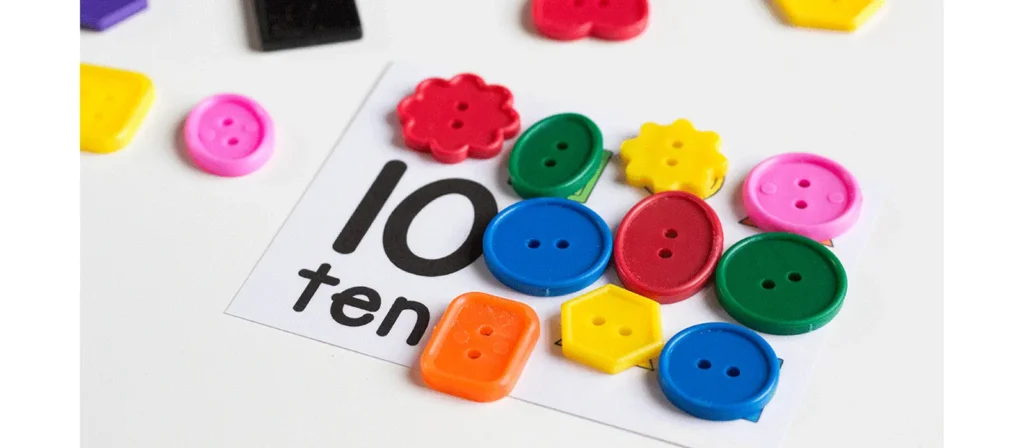
Benefícios: This activity helps develop counting skills, estimation, and number recognition. It encourages children to practice basic math skills in a fun, interactive way.
38. Weather Word Matching
How it Works: The teacher shows images or flashcards of various weather conditions (sunny, rainy, snowy, cloudy, etc.) and asks the children to match them with words or actions that describe the weather. For example, for “rainy,” children might act like they are holding an umbrella.
Benefícios: This activity enhances vocabulary, weather knowledge, and social-emotional development. It encourages children to connect words with actions, strengthening their language and motor skills.
39. Rhyming Relay
How it Works: Children are split into two teams. The teacher says a word (e.g., “cat”), and each team member must race to say a word that rhymes with it (e.g., “hat”). The first team to complete the rhyming relay wins.
Benefícios: This activity boosts phonological awareness and helps with language development. It encourages quick thinking and teamwork while reinforcing word patterns and rhyming.
40. Alphabet Yoga
How it Works: Each child stands in a circle and follows the teacher’s lead to create yoga poses inspired by the letters of the alphabet. For example, “A” could involve arms raised above the head in a triangle pose, and “B” could involve a balanced pose with legs bent.

Benefícios: This activity combines physical movement with letter recognition, promoting gross motor skills and early literacy. It encourages mindfulness, flexibility, and focus while introducing children to basic yoga poses.
Não sonhe, projete! Vamos conversar sobre suas necessidades de móveis personalizados!
How to Plan Circle Time Activities?
Planning circle time activities is vital to creating an engaging, structured, and educational experience for preschoolers. A successful circle time should encourage learning, social interaction, and development in a way that captivates the children’s attention. Here’s how to plan practical circle time activities:
Set Clear Objectives
Before planning circle time activities, it’s important to define the goals for circle time. Consider what you want the children to learn or practice. Objectives can range from enhancing social skills, teaching colors or shapes, improving language development, or fostering emotional expression. Knowing your goals will guide the selection of circle time activities.
Example Goals:
- Improve listening skills.
- Encourage self-expression and emotional understanding.
- Foster teamwork and cooperation.
- Reinforce basic concepts (such as shapes, numbers, colors).
Choose Age-Appropriate Activities
Select circle time activities that are developmentally appropriate for the children’s age and abilities. Preschoolers have limited attention spans, so choosing short, engaging, and interactive activities is essential. Vary the activities to incorporate active, quiet, and hands-on experiences.
Plan a Flexible Schedule
While routine is essential in circle time activities, be flexible with the schedule based on the children’s moods and needs. A typical circle time session lasts 15 to 30 minutes, depending on the children’s attention span. Ensure you have a mix of circle time activities that vary in pace.
Incorporate a Variety of Learning Styles
Children learn differently—some are auditory learners, some are visual, and others are kinesthetic. To keep all children engaged, ensure that your circle time activities cater to multiple learning styles. Use songs, visual aids, hands-on materials, and physical circle time activities to reach children with different preferences.
Engage Children with Interactive Activities
Circle time activities should be an interactive experience that allows children to participate actively. Instead of just listening, encourage children to respond, ask questions, and perform actions. The more involved the children are, the better they will absorb the information and concepts you introduce.
Use Positive Reinforcement
Incorporate positive reinforcement to encourage participation and good behavior. Praise the children when they follow instructions, share ideas, or stay focused during the activity. This can be as simple as a smile, verbal praise, or a reward system like stickers.
Examples of positive reinforcement:
- Verbal praise: “Great job, Sarah! I love how you’re paying attention.”
- Visual rewards: Stickers, stamps, or a special spot in the circle.
- Encouragement: “Wow, you remembered the song perfectly!”
Prepare Materials Ahead of Time
To ensure that circle time flows smoothly, prepare all your materials beforehand. This can include storybooks, props, flashcards, music, or any items required for hands-on circle time activities. When materiais educacionais are ready, you won’t waste time searching for them and can maintain the children’s attention.
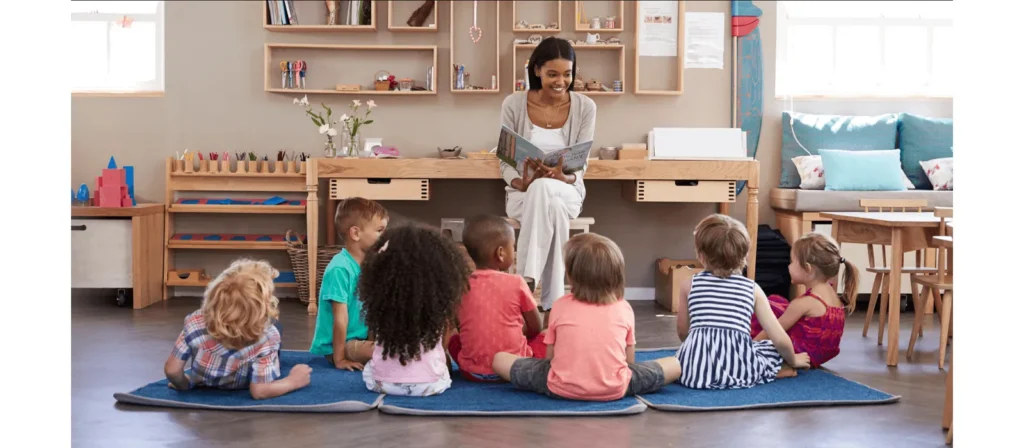
Examples of materials to prepare:
- Books for storytime.
- Flashcards for games or lessons.
- Musical instruments or props for songs and rhymes.
- Craft supplies for hands-on projects.
Create a Comfortable Space
Circle time activities require a designated space where all children can comfortably see and participate. Arrange seating so all children can sit in a circle, with enough space for movement if necessary. Keep the area free from distractions, and create a cozy, inviting atmosphere with rugs or pillows.
Incorporate a Consistent Routine
While mixing up activities is important, maintaining a consistent structure within circle time helps children feel secure and know what to expect. Start each session with a welcoming activity, follow with an interactive lesson, and end with a calming or reflective activity. The structure helps build a sense of predictability and security.
Things to Avoid During Circle Time Activities
Circle time is a critical part of preschool education, but just as important as knowing what to include in your activities is knowing what to avoid. You can ensure a smooth, engaging, and educational experience for the children by avoiding certain pitfalls. Here are some things to avoid during circle time activities:
Overloading with Information
Preschoolers have short attention spans, and overwhelming them with too much information during Circle time activities can lead to disengagement. Focus on one concept at a time to ensure children can absorb and retain the lesson effectively.
Lack of Movement or Interaction
Circle time activities should encourage movement and interaction to keep children engaged. Without activities that involve physical movement or group participation, children may become restless, making it harder for them to focus and learn.
Too Much Sitting in One Spot
Sitting still during circle time activities can lead to discomfort and restlessness. Mix setting with activities that allow children to move, stand, or participate in interactive games to maintain their attention.
Not Using Visuals or Props
Circle time activities should incorporate visuals or props to aid children’s understanding. Visual aids like flashcards or storybooks help reinforce concepts and keep children’s attention focused, especially since preschoolers are strong visual learners.
Inconsistent Routines
A lack of routine during circle time activities can confuse preschoolers. Establishing a predictable flow helps children feel more secure and focused, making it easier to transition between activities and stay engaged.
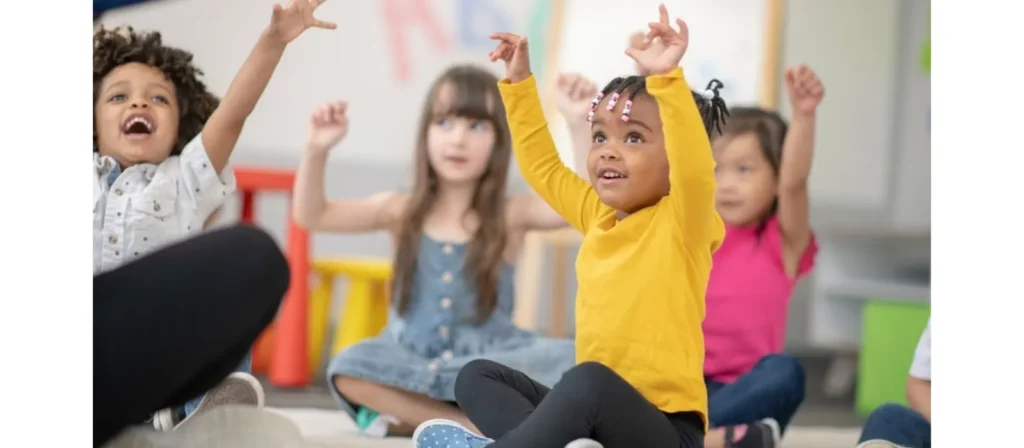
Ignoring Individual Needs
In circle time activities, every child’s needs should be considered. Ignoring these needs can prevent full engagement. Adapt activities to ensure all children can participate and learn effectively, regardless of their abilities or developmental stage.
Lack of Enthusiasm
A lack of enthusiasm during circle time activities can lead to disengagement. Your energy and excitement are contagious, and by showing enthusiasm, you inspire children to participate actively and stay focused throughout the activity.
Sua sala de aula perfeita está a um clique de distância!
Conclusão
Circle Time activities are integral to a preschooler’s daily routine, providing valuable opportunities for children to develop essential social, emotional, cognitive, and physical skills in a collaborative environment. By incorporating engaging and interactive circle time activities, educators can foster creativity, encourage teamwork, and support children in building foundational skills like language development, problem-solving, and emotional expression.
When thoughtfully planned and executed, circle time activities become more than just a structured part of the day—they become a time for children to bond with peers, express themselves, and grow individually and as part of a group. Educators can enrich these moments by continuously incorporating fun and meaningful activities into circle time, setting a strong foundation for lifelong learning and social development.



